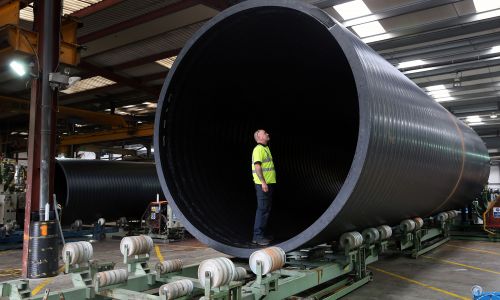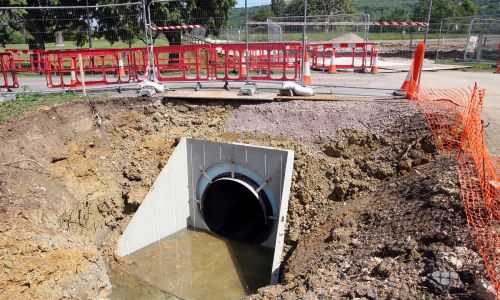12th April 2017
If you had £500 billion how would you spend it..?
… Well if you’re the UK Government it’s all about infrastructure, infrastructure, infrastructure.
In December 2016 the government published details of its £500 billion-plus infrastructure investment pipeline, which outlines the UKs major ‘shovel ready’ projects, including the Thames Tideway Tunnel, HS2, Crossrail, the rollout of smart meters, a multitude of flood defences and hundreds of other schemes.
The money comes from a mix of private and public investment, with more than 40% being delivered by the government.
The pipeline comes hot on the heels of the Chancellor’s Autumn Statement announcement of the new £23 billion National Productivity Investment Fund. This new fund includes infrastructure investments of over £2.6 billion to improve transport networks; a multi-million pound package to improve UK broadband connectivity and £7.2 billion to support the construction of hundreds of thousands of new homes.
The new National Infrastructure and Construction Pipeline merges these two pipelines, delivering on a pledge made in the Infrastructure & Projects Authority (IPA) National Infrastructure Delivery Plan, which set out the government’s plans to support the delivery of housing, and social and economic infrastructure.
The intention is that its delivery will boost our productivity in the long-term – a critical factor in the ability to raise living standards and wages. Simply put if the UK raised its productivity by one percentage point every year within a decade it would add £240 billion to the size of the economy; that’s £9,000 for every household in Britain. So clearly investing in better infrastructure is at the heart of the government’s ambitious plans to close the UK’s productivity gap.
It will also enable Britain to better plan for future skills and resource needs, increase market confidence, and support industry to invest and allocate resources effectively.
So what are the projects that have been rubber stamped for action and which are designed to fast track the UK economy and drive growth? Here are just a handful of the major schemes that have a price tag in the tens of billions.
Thames Tideway Tunnel
Cost: Approx £4.5 billion
London’s Victorian sewerage system is regarded as no longer fit for purpose and spills millions of tonnes of sewage into the river every year. The Thames Tideway Tunnel is a major new sewer that is urgently needed to protect the tidal River Thames from pollution.
Construction of the Thames Tideway Tunnel began last year and will take seven to eight years to complete. Once constructed, the main tunnel will have an internal diameter of 7.2m and will run for over 16 miles under central London. It will connect 34 of the most polluting combined sewer overflows (CSOs), via transfer tunnels, and it is expected to reduce the number of overflow events to a maximum of four per CSO per year. The tunnel will transfer the captured sewage to the Lee Tunnel for onward delivery to Beckton Sewage Treatment Works for treatment. The recycled clean water will then be released into the River Thames (www.tideway.london)
Hinkley Point C
Cost: Approx £18 billion (construction cost), with total lifetime cost estimated at £37 billion
Hinkley Point C nuclear power station (HPC) is a project to construct a 3,200 MWe nuclear power station with two EPR reactors in Somerset. The plant, is the first nuclear power plant to be built in a generation and has a projected lifetime of sixty years. It is expected to take owners EDF Energy over ten years to construct and create over 25,000 jobs, with over 1,600 workers on site each day. To date the concrete has been poured to build the first permanent structures at the power station and construction has begun on a 500m temporary jetty which will bring 80% of materials to the site by sea. Once complete it will deliver 7% of the UKs electricity requirements. (https://www.edfenergy.com/energy/nuclear-new-build-projects/hinkley-point-c)
High Speed 2
Cost: Approx £56 billion
High Speed 2 (HS2) is a planned high-speed railway linking London, Birmingham, the East Midlands, Leeds and Manchester. It has been described as the most extravagant infrastructure project in our history. It will be the second high-speed rail line in Britain, after High Speed 1 (HS1) which connects London to the Channel Tunnel. The cities of Carlisle, Edinburgh, Glasgow, Liverpool, Newcastle, Preston, Sheffield and York will be linked to the network by HS2 trains running over existing slower tracks, or edge-of-town HS2 stations. Numerous benefits include: peak hour capacity leaving Euston will more than triple increasing from 11,300 to 34,900; Leeds to Birmingham journey slashed from 1 hour 58 minutes to just 57 minutes and Manchester to Birmingham more than halves from 88 to 41 minutes; West Midlands said to gain most in absolute terms with a rise of £1.5bn-£3.1bn in output by 2037. (https://www.gov.uk/government/organisations/high-speed-two-limited)
Priority School Building Programme
Cost: Approx £4.4 billion
The Priority School Building Programme (PSBP) involves the rebuilding and refurbishing of school buildings in the worst condition across the country. There are two phases of the programme covering a total of 537 schools. Under the first phase, PSBP1, 260 schools are being rebuilt and/or refurbished. The vast majority of the first phase will be open by the end of 2017, two years earlier than announced. Under the second phase, PSBP2, individual blocks at 277 schools will be rebuilt and refurbished. The Education Funding Agency plans for all PSBP2 schools to open their new or refurbished buildings by the end of 2021. (https://www.gov.uk/government/collections/priority-school-building-programme-psbp)
Full details of the National Infrastructure and Construction Pipeline can be viewed here: https://www.gov.uk/government/news/uk-infrastructure-investment-to-reach-record-high



